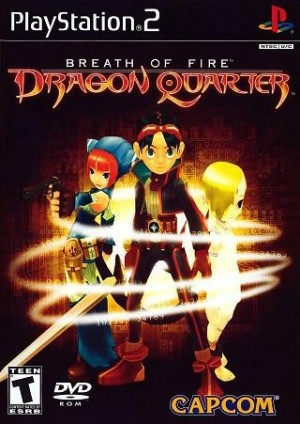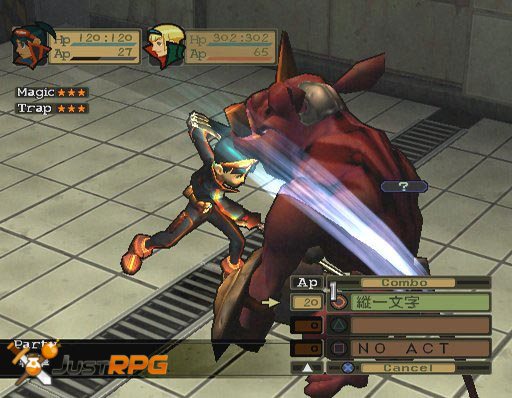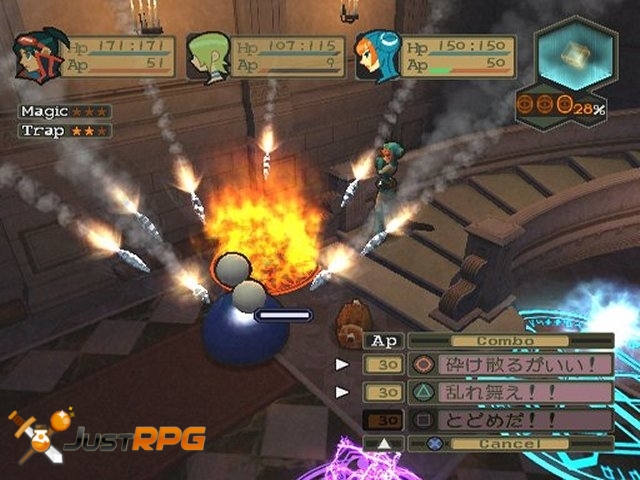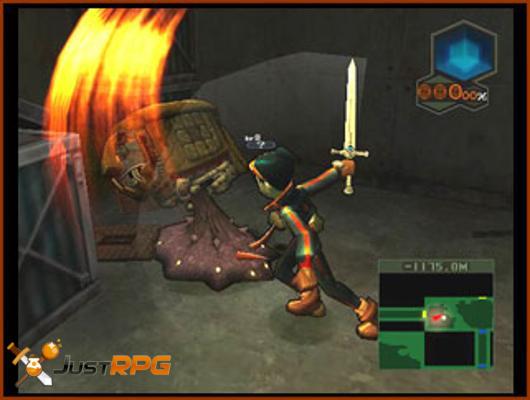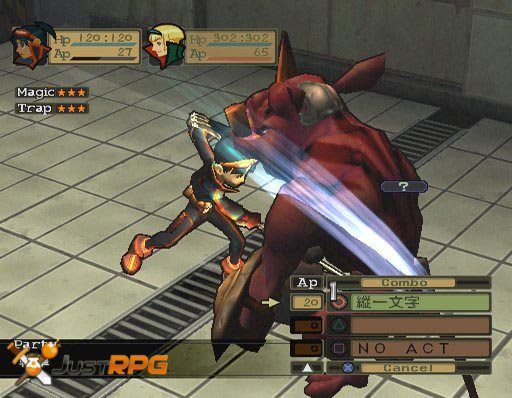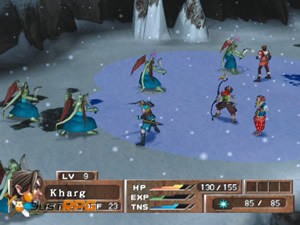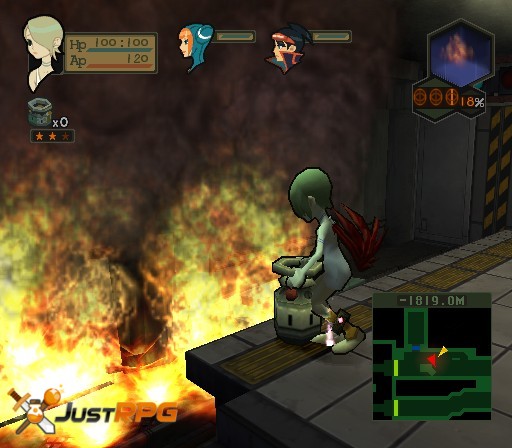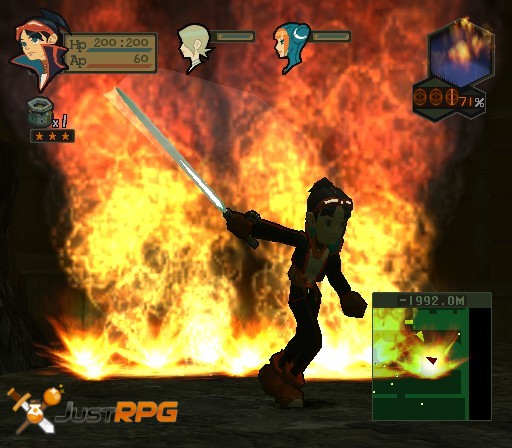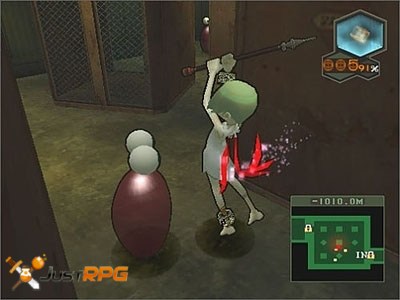Breath of Fire: Dragon Quarter
Breath of Fire: Dragon Quarter is a new spin on the Breath of Fire series. Players take control of another boy named Ryu as he attempts to save the girl he cares about, an in turn reset the status quo of the world he lives in.
Breath of Fire: Dragon Quarter Overview
Players take control of a boy named Ryu, who lives underground just like everyone else. Humanity in this story has fled underground because of a cataclysmic event in the far past. Sadly, they have started to stagnate, and the underground societies are falling apart. Ryu is a ‘lower class’ member of said society, and so is confined to the lowest, most polluted areas of his world. His friend, Nina, is experimented on, and is unable to live underground anymore. So, Ryu sets out to save her from her eventual death by making his way to the surface world, inadvertently coming to blows with the leader of the society, a man who wants to steal Ryu’s shape shifting capabilities.
Breath of Fire: Dragon Quarter Screenshots
Breath of Fire: Dragon Quarter Video
[youtube]http://www.youtube.com/watch?v=DsfKK8uYdY4[/youtube]
Breath of Fire: Dragon Quarter Review
By, Ronald Wartow
Backdrop
Breath of Fire: Dragon Quarter (BoFDQ) is the highly anticipated fifth installment of a much admired series of RPG’s. So, why not call the game Breath of Fire V: Dragon Quarter? Though this is the title of the Japanese version released months ago, our version’s title clearly omits the “V”.
Perhaps, this is because this game is absolutely nothing like its highly thought of, old school, 40+ hour RPG predecessors, whose large, beautifully-drawn populated overworlds, multiple dragon transformations, and clever puzzles are gone. All that’s left is “Dragon Boy” Ryu, the winged-mystic, Nina, and but a single dragon conversion for Ryu. Not only is the game completely different and shorter, but expect a particularly tough challenge.
All the action takes place in an almost deserted, claustrophobic, dank, gloomy, cavernous complex, where narrow corridors are the norm. NPC dialogue is threadbare, and few settlements exist, though the game’s merchants follow the party.
Does this make for a positive new direction, a forgettable side trip, or a severe body blow destroying all the positive elements that the games’ loyalists fondly remember? Online traffic since the game’s recent release shows a deep division among players. Many applaud the innovation and challenge, while others complain that the series is ruined because of the exact same things. (Maybe, it’s best to be new to the series, without preconceived notions, so the game can be judged on its own merits.)
The setting is a future world torn asunder in a dark future. No one can remember ever having seen the sky. Everyone lives in diminutive settlements over 1000 feet deep underground. All cringe at the mercy of a dastardly biological research lab, performing experiments too unspeakable to reveal. In this bleakness, our old buddy, Ryu, toils as an unranked Ranger protecting society, when he discovers what all of us knew was coming, his ability to transform into a mighty dragon. After messing with the wrong people, and a shocking discovery about a cohort, Ryu and company embark on a long and dangerous trek upward to the world‘s surface. The storyline is reasonably gripping, and a few twists and turns occur before the climactic ending.
Gameplay
Far from standard RPG fare, BoFDQ debuts three systems for the series, one for pre-combat, one for combat, and one that encourages restarting and replaying the game often. The three together plus other gameplay features make this kind somewhat unique.
The Positive Encounter and Tactics System (PETS) is designed to give the player a pre-battle advantage. The player finds or buys a healthy variety of traps and decoys. Flinging some meat at a group of monsters will lure them into any location you desire, or separate single monsters, easily picked off, from a wandering group. The well-hurled dynamite or bomb will give monsters a taste of what’s to come, and your party an advantage when combat starts.
The Ability Point System (APS) during combat lets players to take only so many skill or melee actions within the limits of accumulated, available ability points. Every move you make, every breath you take costs ability points. When those points are reduced to zero, or a party member wants to accumulate points for the next turn, the current turn ends . Use your points cleverly, and your next turn may allow multiple attacks next turn. Do the opposite, and you may find yourself in the midst of three monsters bent on your destruction before your next swing.
The Scenario Overlay System (SOL) gives the player two primary options when the dreaded “Game Over“ screen appears, or you are in an untenable position: Restart the game from scratch, but with all experience points and equipment intact, or Restore the game from the last save. Normally, the Restore choice seems to be like many RPG’s; however, in BoFDQ, saving games is very difficult and limited. In a twist, restarting the game with a more robust team also unlocks new story interludes and doors previously bolted, creating, in effect, a different dungeon to be explored. (Does Chrono Trigger come to mind?) We are reminded of the inscription Imhotep scratched on the underside of his sarcophagus after being mummified alive in The Mummy – “Death is only the beginning.” (Was the acronym “SOL” was chosen for its real-world “SOL”, a common invective meaning “S*** Out of Luck”?) It is clear that to unlock all the story interludes and doors in the complex, several retries or restarts are necessary.
Exploring the complex is eased by three helpful and easy to read maps. On the main game screen, a map showing the party’s immediate vicinity is very helpful. A simple button press brings up the level map, showing only those areas already explored. Another button press brings up a global map of the entire complex. Many floors have one special treasure chest with something very worthwhile inside. The toughest monster on each floor usually carries the key.
Experience from combat victories, necessary for character leveling, builds up in two ways. One, the customary method of awarding each character in the party some experience points for combat victories. The other, for efficiency in the combat victory, global party experience points are awarded, and can be split up any way you want among the party members. If you have amassed 300 party experience points, for example, and each of the three in the party needs about 100 points to level, just split up the party experience points three ways, and voila, everyone levels.
In addition to the changing dungeon on replays, BoFDQ contains some engaging, major side activities that provide the player welcome diversions from the constant combat-filled trek upwards. Without giving anything away, there are rumors of many secrets and goings-on. The creative gamer may uncover something huge for exploration, and even something colonial. Both are major undertakings, not just frivolous extras
Saving games is available at Telecorders sparingly scattered throughout the complex. Their scarcity, and that of the unbuyable Save Token to activate it, increase the game’s challenge by several fold. (When you Restore a game, you receive a Save Token.) We fail to understand why the designers made saving the game so harrowing. This system is brutal at times. The designers definitely did this to increase the difficulty, but did they have to make saving so hard? The player can perform a soft save that preserves the gamer’s current position, with everything intact. However, when you restore from the soft save, the data is erased. Worse yet, you cannot copy a soft save to another slot or memory card.
D-counter
The D-counter appears as an animated globe on the main screen after a certain plot event wherein Ryu regains his dragon transformation power. Whenever you use this power, which is incredibly awesome and blows away most every opponent in the game, your counter rises. Other factors can cause it to rise, but, by transforming into a dragon, you pay the heaviest price. If the counter reaches 100%, the game screen literally splashes “GAME OVER”, just as if the party had died in combat.
Constant use of the power guarantees restarting or restoring often. The counter can never, ever be reduced. Of course, restoring a game resets the counter to what it was when the restore took place, and restarting a game returns it to zero. All this is further evidence that the game’s designers want you to replay often. (When the game boots, that scene of Ryu floating clearly expired is definitely a preview of coming attractions.)
Unlike other RPG’s,. this game all but encourages you to die constantly or give up voluntarily, just so you can restart from the beginning. In fact, the main menu screen contains a prominent notice that pressing a particular button will let you “Give Up” While the character is stronger for the experience, repeated restarting requires retracing (Say those last four words three times fast!) of one’s steps. Luckily, the levels are not large, and some monsters do not regenerate. So, getting back to the place where you bought it or gave up can be done in a short period of time. Helping to shorten replay time is your ability to terminate story interludes at any time. (Of course, this would not be advisable for new story interludes opened up by your current replay.) Helpful ways to teleport or warp around the complex do not exist.
D-ratio
The D-ratio is a fractional score based on how quickly you completed the game, how much of the map was explored, and number of saves, among others. Ryu begins the game at an anemic 1/8192. Once you complete a game, the ratio is reassessed. As if by magic, when replaying, certain doors, formerly locked, are now open, additional story interludes play, and the game experience changes. This places the replay value as very high for those who wish to attain a better D-ratio.
Combat
Look forward to turn-based combat, allowing for calm reflection on what strategic steps to take. The APS resembles such games as Final Fantasy Tactics and Tactics Ogre. Unlike those games, the battleground is confined to narrow corridors and spaces, restricting strategic movement somewhat. Like those games, and unlike traditional RPG’s, the monsters are not static. They move around and, depressingly, always seems to head for most-damaged character, or the one inflicting the most damage on them. Amassing action points eventually gives the player one powerful turn against the monsters, with devastating multiple skill attacks called combos, reminiscent of Xenogears.
In combat, the game lets you view the exact order that your party and the enemies will take the next turn. Even better, one of the characters can choose an option to display an informative profile on the monsters being fought. Especially helpful is that the profile gives you information on what elemental attacks will do more damage. When overwhelmed and about to buy the farm, there’s a safety value for escape with a slight performance penalty for the party.
The combat’s tactical feel is a welcome change, and I found combat to be a constantly fresh and rewarding exercise. This is especially so because of the tremendous variety of offensive, defensive, and status magic skills attachable to weapons and armor. Each character can attach up to three skills per level. New and more powerful skills are earned during the more difficult encounters.
Unfortunately, there is no skill to heal, an indefensible oversight, in our view. (One skill very difficult to acquire will heal Ryu, but only to the extent he takes damage.) While healing items are for sale and discoverable, the number the party can carry is limited early on. (A handy Backpack increased items able to be carried, and, from the beginning, a merchant is a portable locker for excess items.) If you need to drop an item to make room in your inventory, it unfortunately disappears into the great void, unable to be retrieved in future. After a few dicey combats, the need for backtracking to buy healing items becomes pressing.
A dungeon foray of any length quickly exhausts the healing items, causing you to backtrack great distances to repurchase more, or press ahead, in constant danger of being wiped out. Often, I found myself devoid of healing items, far from a restocking source. (At least when a character succumbs in combat, it automatically revives with a single hit point, if your party wins.) The player will find no inns or places to rest and restore. This is even true when the team voluntarily returns to a safe haven. Precious currency is wasted on simply healing the returning heroes back to hit point max.
Many pieces of equipment come with distinctive powerful attack, healing, and status skills, essential to combat dominance. The player must tradeoff what skills to equip. Do you activate a skill that will raise defense or offense or something less vigorous that lets you use a powerful skill.
Time for Completion
I completed the game, restarting several times, and exploring most areas available, including new areas uncovered by restart, in 15 hours. I could have lowered the time by cutting down on the restarts to about 12 hours. On the other hand, game time can be extended upwards of 30 hours by continual restarts and runs through the game to earn a lower D-ratio, or spending time with the engaging side activities. Any online buzz that criticizes the game for being just a few hours long is completely way off base.
Multimedia
The game employs cel-shaded graphics, something that boils the blood of many a gamer. The characters are drawn deformed, and, frankly, look like candidates for anorexia therapy. Actually, I found them out-and-out unattractive, and when they change emotions, a so-called special feature, I generally winced with disgust. Playing the game is like being forced to constantly gaze upon an ugly baby for hours on end.
The monsters are nicely drawn and animated, but not in a fist-twirling way. All navigable portions of the complex look about the same. While there are a few graphical differences with certain transitions and areas, do not expect wildly changing eye candy. In keeping with the game’s desolate setting, many areas are rather dim and dark. (There’s no option to brighten the screens.)
Sound and music are excellent, and really get you into the mood for battle and exploration. We particularly liked the death gurgle when a character buys it.
Bottom Line
If you want to relive another game with the same tried and true Breath of Fire RPG formula, we suggest returning to I through IV. Only there, not in BoFDQ, can you find Ryu able to transform into multiple dragon forms, and old school RPG exploration and combat.
For the hardcore RPG’er, this game provides a dynamic challenge that should not be missed. Anyone else should note well that the difficulty level, heightened by the limited saves, item-only healing, and discouraged dragon transformation make this game unsuitable for casual RPG gamers.
Obviously, to get the most out of BoFDQ, you need to play through multiple times. This will not appeal to many gamers, who cherish a game for its length, and that wonderful sigh when the end game cut scenes begin.
Before leaving, we have just 5 words to live by while playing BoFDQ: “When in doubt, go up!”.
Final Verdict: 78%
Breath of Fire: Dragon Quarter Screenshots
Breath of Fire: Dragon Quarter Videos
Breath of Fire: Dragon Quarter Trailer
[youtube]http://www.youtube.com/watch?v=DsfKK8uYdY4[/youtube]
Breath of Fire: Dragon Quarter Game Play
[youtube]http://www.youtube.com/watch?v=Jmcs5DRsxs8[/youtube]

